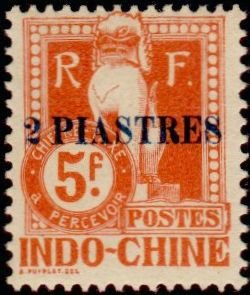Stamp: Dragon of Angkor (French Indochina 1919)
Dragon of Angkor (French Indochina 1919)
01 January (French Indochina ) within release Temple sculpture goes into circulation Stamp Dragon of Angkor face value 2 French Indochinese piastre
| Stamp Dragon of Angkor in catalogues | |
|---|---|
| Yvert et Tellier: | Yt:FR-ICT30 |
| Michel: | Mi:FR ICP 30 |
Stamp is square format.
Stamp Tax overprint new valueAlso in the issue Temple sculpture:
- Stamp - Dragon of Angkor face value 4/5;
- Stamp - Dragon of Angkor face value 1⅗;
- Stamp - Dragon of Angkor face value 2;
- Stamp - Dragon of Angkor face value 4;
- Stamp - Dragon of Angkor face value 6;
- Stamp - Dragon of Angkor face value 8;
- Stamp - Dragon of Angkor face value 12;
- Stamp - Dragon of Angkor face value 16;
- Stamp - Dragon of Angkor face value 20;
- Stamp - Dragon of Angkor face value 24;
- Stamp - Dragon of Angkor face value 24;
- Stamp - Dragon of Angkor face value 40;
- Stamp - Dragon of Angkor face value 40;
- Stamp - Dragon of Angkor face value 80;
- Stamp - Dragon of Angkor face value 2;
Stamp Dragon of Angkor it reflects the thematic directions:
Sculpture is the branch of the visual arts that operates in three dimensions. Sculpture is the three-dimensional art work which is physically presented in the dimensions of height, width and depth. It is one of the plastic arts. Durable sculptural processes originally used carving (the removal of material) and modelling (the addition of material, as clay), in stone, metal, ceramics, wood and other materials but, since Modernism, there has been almost complete freedom of materials and process. A wide variety of materials may be worked by removal such as carving, assembled by welding or modelling, or moulded or cast.
A temple (from the Latin word templum) is a building reserved for religious or spiritual rituals and activities such as prayer and sacrifice. It is typically used for such buildings belonging to all faiths where a more specific term such as church, mosque or synagogue is not generally used in English. These include Hinduism, Buddhism, and Jainism among religions with many modern followers, as well as other ancient religions such as Ancient Egyptian religion.

